A) the marginal rate of substitution of X for Y is greater than it is at point B.
B) the ratio of the price of X to the price of Y is greater than it is at point B.
C) the consumer's utility is less than it is at point B.
D) both a and c
E) all of the above
Correct Answer

verified
Correct Answer
verified
Multiple Choice
Based on the following graph,if the price of X is $7.50 per unit,how many units of X will a utility-maximizing consumer choose? 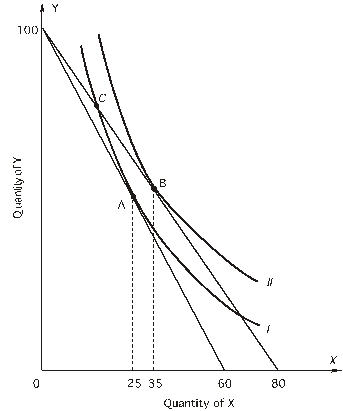 The consumer's income is $600.
The consumer's income is $600.
A) 25
B) 30
C) 35
D) 50
E) none of the above
Correct Answer

verified
Correct Answer
verified
Multiple Choice
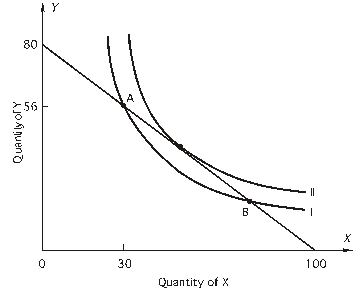 The consumer's income is $800.
-According to the above figure,why doesn't the consumer choose the combination of 30X and 56Y at point A?
The consumer's income is $800.
-According to the above figure,why doesn't the consumer choose the combination of 30X and 56Y at point A?
A) MRS is less than ![]() .
.
B) MRS is greater than ![]() .
.
C) ![]() is greater than
is greater than![]() .
.
D) ![]() is less than
is less than![]() .
.
Correct Answer

verified
Correct Answer
verified
Multiple Choice
Lulu consumes only candy and cookies; she is currently buying more cookies than candy with her limited income.The last bag of candy gave Lulu the same additional utility as the last bag of cookies,and the prices of candy and cookies are the same.Lulu
A) is maximizing utility given a limited income because the prices of candy and cookies are the same.
B) is maximizing satisfaction given a limited income because the marginal utility per dollar is the same for candy and cookies.
C) could get more satisfaction from the same income by buying more candy and less cookies.
D) could get more satisfaction from the same income by buying more cookies and less candy.
Correct Answer

verified
Correct Answer
verified
Multiple Choice
Which of the following is NOT a characteristic of a typical indifference curve?
A) The curve shows all combinations of goods that give the consumer the same level of utility.
B) As a consumer has less of a good,he is less willing to exchange less of it for one more unit of another good.
C) The marginal rate of substitution is measured by the slope of the tangent to the curve.
D) The curve will shift out if income increases.
Correct Answer

verified
D
Correct Answer
verified
Multiple Choice
According to the Rolling Stones,"You can't always get what you want." Which does this mean in the context of utility maximization?
A) A bundle of goods between the budget line and the origin
B) Vertical indifference curves
C) A bundle of goods above the budget line
D) Horizontal indifference curves
Correct Answer

verified
Correct Answer
verified
Multiple Choice
Assume James purchases only two goods,steak and chicken,with his weekly income of $60.The price of steak is $10 and the price of chicken is $5.The following table shows the marginal utility James gets from each additional pound of steak and chicken:  Given the above information,if the price of steak falls to $8,what quantities of steak and chicken should James purchase to maximize his utility?
Given the above information,if the price of steak falls to $8,what quantities of steak and chicken should James purchase to maximize his utility?
A) 6 steak,2 chicken
B) 5 steak,3 chicken
C) 4 steak,4 chicken
D) 5 steak,4 chicken
E) 3 steak,6 chicken
Correct Answer

verified
Correct Answer
verified
Multiple Choice
Suppose a consumer who purchases only two goods is making a utility-maximizing choice and then the price of one of the goods decreases.What will happen?
A) The consumer's purchasing power will increase.
B) The consumer's total utility will increase.
C) The consumer's money income will increase.
D) both a and b
E) all of the above
Correct Answer

verified
Correct Answer
verified
Multiple Choice
Which of the following assumptions isare) NOT made in consumer behavior theory?
A) Consumers can rank all bundles of goods.
B) Consumers can measure the utility they get from all bundles of goods.
C) Consumers have complete information.
D) both a and b
E) None of the above are assumptions made in consumer behavior theory.
Correct Answer

verified
Correct Answer
verified
Multiple Choice
If Ferdinand prefers a Big Mac to a Whopper and a Whopper to a hotdog,but is indifferent between a Big Mac and a Quarter Pounder he must
A) prefer a Quarter Pounder to a hotdog.
B) prefer a Whopper to a Quarter Pounder.
C) be indifferent between a Quarter Pounder and a Whopper.
D) be indifferent between a Whopper and a hotdog.
Correct Answer

verified
A
Correct Answer
verified
Multiple Choice
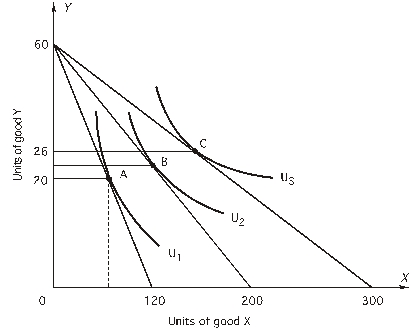 The price of Y is $10.
-According to the above figure,if the price of X is $5,what combination of X and Y will a utility-maximizing consumer choose?
The price of Y is $10.
-According to the above figure,if the price of X is $5,what combination of X and Y will a utility-maximizing consumer choose?
A) 80X,20Y
B) 120X,620Y
C) 120X,250Y
D) 200X,620Y
E) none of the above
Correct Answer

verified
Correct Answer
verified
Multiple Choice
Based on the following graph,at point C, 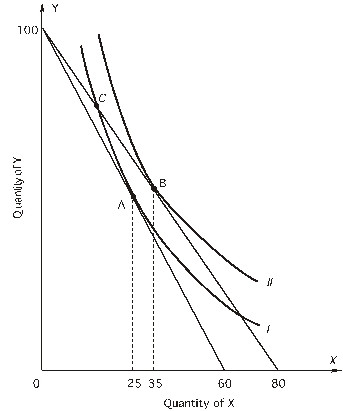 The consumer's income is $600.
The consumer's income is $600.
A) MRS is greater than 1.25.
B) MRS is less than 0.4.
C) MRS is greater than 2.
D) MRS is less than 2.5.
Correct Answer

verified
Correct Answer
verified
Multiple Choice
Suppose that 2 units of X and 8 units of Y give a consumer the same satisfaction as 4 units of X and 2 units of Y.Then
A) the consumer is willing to give up 3 units of Y to obtain 1 more unit of X.
B) the consumer is willing to give up 1 unit of Y to obtain 3 more units of X.
C) the marginal rate of substitution of Y for X is 3.
D) both a and c
E) both b and c
Correct Answer

verified
Correct Answer
verified
Multiple Choice
According to the following graph,if U2 is the maximum attainable utility,the price of X is 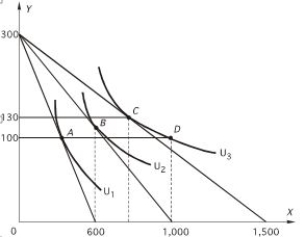 The price of Y is $50.
The price of Y is $50.
A) $10.
B) $15.
C) $20.
D) $25.
E) none of the above
Correct Answer

verified
Correct Answer
verified
Multiple Choice
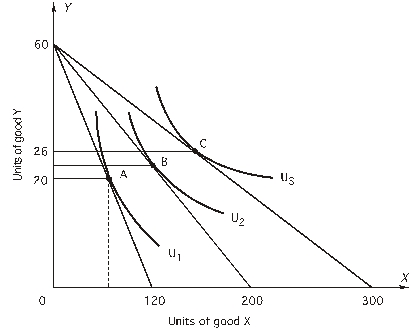 The price of Y is $10.
-According to the above figure,which of the following are points on the consumer's demand curve for X?
The price of Y is $10.
-According to the above figure,which of the following are points on the consumer's demand curve for X?
A) $2,300 units
B) $3,120 units
C) $5,120 units
D) both a and b
E) both c and d
Correct Answer

verified
Correct Answer
verified
Multiple Choice
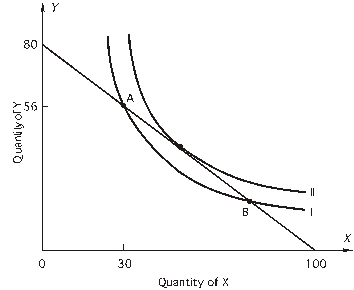 The consumer's income is $800.
-According to the above figure,why doesn't the consumer choose the combination at point B?
The consumer's income is $800.
-According to the above figure,why doesn't the consumer choose the combination at point B?
A) The consumer is willing to give up more X for additional units of Y than the rate in the market.
B) The marginal utility of Y exceeds the marginal utility of X.
C) The marginal utility per dollar spent on Y exceeds the marginal utility per dollar spent on X.
D) both a and c
E) both b and c
Correct Answer

verified
D
Correct Answer
verified
Multiple Choice
Suppose that utility-maximizing consumers in San Francisco pay three times as much for apples as for peaches.What is the ratio of the marginal utility of apples to the marginal utility of peaches?
A) 1/3
B) 2/3
C) 3
D) none of the above
E) cannot determine without further information
Correct Answer

verified
Correct Answer
verified
Multiple Choice
According to the following graphs,at point B, 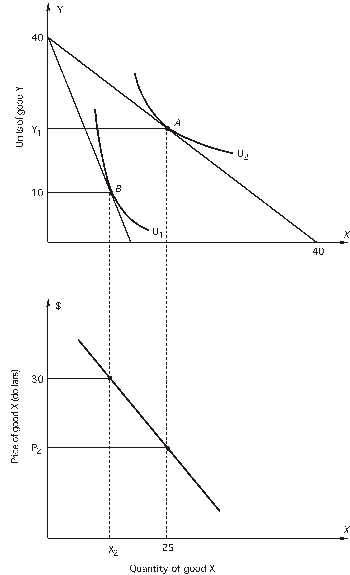 The price of Y is $15 per unit.
The price of Y is $15 per unit.
A) the consumer can exchange one unit of X for one unit of Y and keep income unchanged.
B) the marginal rate of substitution of X for Y is greater than it is at point A.
C) the consumer's utility is greater than it is at point A.
D) both a and b
E) all of the above
Correct Answer

verified
Correct Answer
verified
Multiple Choice
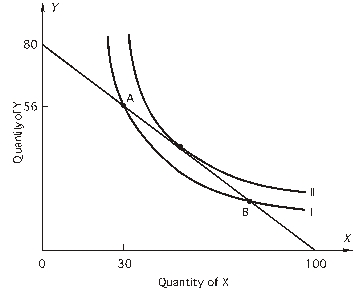 The consumer's income is $800.
-According to the above figure,what are the prices of goods X and Y?
The consumer's income is $800.
-According to the above figure,what are the prices of goods X and Y?
A) ![]() = $10,
= $10,![]() = $8
= $8
B) ![]() = $8,
= $8,![]() = $10
= $10
C) ![]() = $100,
= $100,![]() = $80
= $80
D) ![]() = $20,
= $20,![]() = $60
= $60
E) ![]() = $60,
= $60,![]() = $20
= $20
Correct Answer

verified
Correct Answer
verified
Multiple Choice
If Mary prefers bananas to plums and plums to peaches,but is indifferent between bananas and oranges,she
A) prefers oranges to peaches.
B) prefers plums to oranges.
C) is indifferent between oranges and plums.
D) is indifferent between oranges and peaches.
Correct Answer

verified
Correct Answer
verified
Showing 1 - 20 of 69
Related Exams